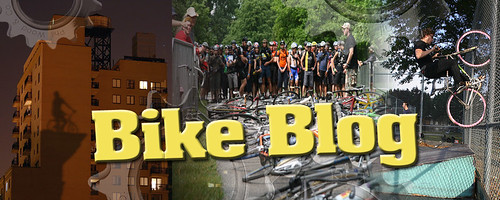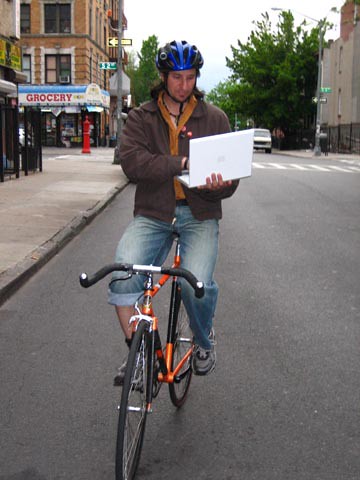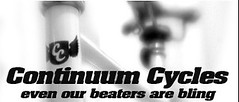How bout cyclo-cross
Here is a recent article on the true nature of cyclo-cross and why its so popular to get down and dirty.
Cyclocross: Mud, sweat and gears.
published in the Escapes section of the NYTimes
Friday, November 30th by: Stephen Regenold
Photo by: T.C. Worley for the NY Times.
UP AND OVER Mark Weispfenning, one of 160 competitors at the Grumpy’s cyclocross race in Blaine, Minn., leaps a barrier as he holds his cross bike.

ABOVE the pool of filth, but still within the shadow of the ditch, my bike skidded sideways in muck. “Heads up!” yelled a fellow racer, elbow out, body a blur.
It was lap No. 5 at Grumpy’s CX, a cyclocross bike race in Blaine, Minn., and I was fighting for position in a deep gulch of mud.
“On your left!” a rider yelled, tires squishing through the ooze.
The race had kicked off 20 minutes before, a crush of cyclists squeezing through a start gate to the two-kilometer course beyond. What would come included a gravel track, pavement, grass, switchback climbs and multiple knee-high barriers that forced riders to dismount, shoulder their rigs and hurdle on foot before hopping back on their bikes to race away.
Cyclocross, a growing off-road discipline, appears at first to be an amalgam of BMX bike racing and road riding. The sport’s short, looped courses include obstacles, ramps, bumps, sand pits, sharp turns and lots of the aforementioned mud — all navigated on a road-bike-like cycle that has drop-bar handles, skinny tires and no suspension.
Cyclocross, invented nearly 100 years ago in Europe as an off-season training regimen for road-bike racers, has a storied tradition and a worldwide following. Internationally, professional competition is administered by the Union Cycliste Internationale, the Swiss organization that also oversees the Tour de France.
And in the United States, a longtime dead zone for cyclocross, the sport has recently caught fire.
“We’re seeing a cyclocross phenomenon of sorts in this country,” said Stuart Thorne, a former professional cyclocross rider from Wenham, Mass., who now runs the online publication CyclocrossWorld.com. “A race in Oregon last month drew nearly 1,000 cyclocross racers, which was one of the biggest showings ever.”
About 40,000 cyclists registered to race in a cyclocross event last year, according to USA Cycling, a Colorado Springs organization that sanctions competitions. That’s up from 17,000 registered racers in 2004.
Cyclocross is a fall sport, with races starting in September and continuing every weekend past Thanksgiving. Hundreds of races are held each year nationwide, many organized into regional series, from Maine to Colorado to California. USA Cycling’s season-ending Cyclocross National Championships this year are in Kansas City, Kan., Dec. 13 to 16.
“Cyclocross caters to the abilities of both road cyclists and mountain bikers,” said Andy Lee, director of communications for USA Cycling. “Thus, it draws from both worlds.”
Mountain bikers, Mr. Lee said, excel at the technical off-road terrain. Road cyclists bank on power and speed honed from pedaling on pavement. Cyclocross’s idiosyncrasies — from sand traps and standing water to the get-off-your-bike-and-leap barriers — necessitate technique specific to the sport.
“There’s an art to popping off, shouldering your bike, then getting back on without losing speed,” said Mark Mettler, a 45-year-old road cyclist from Minnetonka, Minn. Mr. Mettler spins through 36 road races a year, starting in the spring and pedaling through the end of August. Then he moves on to cross, as its riders tend to call it. “You build a base all summer road racing,” he said, “then you’re fit and ready when cyclocross season starts.”
At Grumpy’s CX — a race held earlier this month in Blaine, Minn., that drew 160 competitors — Mr. Mettler and dozens of road riders, almost all men, tried to hold their own against a smaller crowd of mountain bikers. Most rode cyclocross-specific bikes, which — unlike mountain bikes — have stiff forks and thin, knobby tires, trading shock absorption and some traction for a cross bike’s bigger gears, lighter weight and inherent speed.
Other riders pedaled pared-down single-speed bikes. There were track bikers and road specialists who came to try the sport for the first time. A contingent of urban bike messengers with tattoos, nose rings and knickers rounded out the field. “There’s a wide demographic in this sport,” said Robert Danneker, a Grumpy’s CX organizer.
I rode in the first race of the day, a half-hour-long lap event open to neophytes on up to intermediate riders.
Our heat began at the shout of an official: “Racers ready, and go!” Wheels started to turn. Pedals clicked. Riders leaned in to fight for position.
“Come on! Come on!” yelled a racer in the back.
The course, set on the grounds of the National Sports Center athletics campus, twisted and turned on grass at first, with little orange flags and police tape strung to sequester the lanes. It climbed a hill and then dropped on a carpeted ramp into a velodrome track-bike stadium — the first of many oddities encountered on the course.
A crowd cheered from bleachers above the track. “Go Mike!” someone shouted. “Let’s hit it, guys!”
Three barriers — stout 16-inch-high wooden walls — blocked the lane inside the stadium. Brakes squeaked in abrupt goose honks as the pedaling procession slowed to dismount and jump.
I swung a leg over my bike’s frame before slowing, coasting on one pedal for five feet. Then it was: unclip from the pedal; hit the grass running; grab the bike; hoist it; gallop; and leap.
Ozzy Osbourne blared on the stadium speakers: “I’m going off the rails on a crazy train ...”
The mud pits came next. The first one — a sulfur-smelling mess — was a dis-aster, with riders flipping, feet flying over handlebars, as a fist of riders again collectively slammed on the brakes.
“Look out!” one downed competitor screamed.
The course swung east on a straightaway. It dived down a ditch to a long channel of mud. Grit crunched in gears. Brakes chattered through tight turns.
A race official shouted as I flew by the start area: “Rider 275,” he piped, noting the number on my bib. A tally of each rider’s laps would determine race standings.
And so I started on lap No. 2, a few minutes into the race, pedaling somewhere in the middle of the pack. Mud was already matted on my legs. Sweat dribbled off my nose.
I cranked up a hill and leaned into a turn, straining to see ahead. Tires searched for grip. Dirt flew. Fans screamed. Riders whizzed by, pedaling to hurdles and ramps and mud pits beyond.
It was a strange show, and I was happy to be a part of the act.
---------------------------------
There are also some urban cyclocross events including...the 2nd annual Bilenky Urban Cyclo Cross Race. Sunday, December 9th. 3:00pm
Yes this race is hosted by the fine independent bike makers of Bilenky and yes its held in a junk yard.

Here are some pictures from last year.
more details on Belinky's Location: Bilenky is on north 2nd street in north north philly. Google maps shows what might be a junkyard just east of 5319 N 2nd St, Philadelphia, PA. (But email for more info...looks like mad fun)
Here is a video from a recent cyclocross event held in Delaware:











0 Comments:
Post a Comment
<< Home